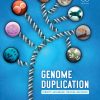Chemistry and Biology of Hyaluronan 1st Edition by Hari G Garg, Charles A Hales ISBN 0120200341 9780120200344
$50.00 Original price was: $50.00.$35.00Current price is: $35.00.
Chemistry and Biology of Hyaluronan 1st Edition by Hari G Garg, Charles A Hales – Ebook PDF Instant Download/Delivery: 0120200341, 9780120200344
Full download Chemistry and Biology of Hyaluronan 1st Edition after payment

Product details:
ISBN 10: 0120200341
ISBN 13: 9780120200344
Author: Hari G Garg, Charles A Hales
It was probably the French chemist Portes, who first reported in 1880 that the mucin in the vitreous body, which he named hyalomucine, behaved differently from other mucoids in cornea and cartilage. Fifty four years later Karl Meyer isolated a new polysaccharide from the vitreous, which he named hyaluronic acid. Today its official name is hyaluronan, and modern-day research on this polysaccharide continues to grow.
Expertly written by leading scientists in the field, this book provides readers with a broad, yet detailed review of the chemistry of hyaluronan, and the role it plays in human biology and pathology. Twenty-seven chapters present a sequence leading from the chemistry and biochemistry of hyaluronan, followed by its role in various pathological conditions, to modified hylauronans as potential therapeutic agents and finally to the functional, structural and biological properties of hyaluronidases. Chemistry and Biology of Hyaluronan covers the many interesting facets of this fascinating molecule, and all chapters are intended to reach the wider research community.
* Comprehensive look at the chemistry and biology of hyaluronans
* sential to Chemists, Biochemists and Medical researchers
* broad yet detailed review of this rapidly growing research area
Chemistry and Biology of Hyaluronan 1st Table of contents:
Chapter 1. Solution Properties of Hyaluronan
I. Introduction
II. Historical Perspective
III. Fundamentals of Hyaluronan Properties
IV. Conformation of Hyaluronan in Solution
V. Concentration Dependence of Hyaluronan Self-Diffusion
VI. Effects of Electrolytes on Hyaluronan Solution Properties
VII. The Effects of Alkali pH on Hyaluronan Self-Diffusion and Tracer Diffusion in Hyaluronan Soluti
VIII. Temperature Dependence of Hyaluronan Self-Diffusion
IX. Effects of Urea on Hyaluronan Properties
X. Effects of Hyaluronan Oligosaccharides on Polymeric Hyaluronan Properties
XI. Conclusions
Chapter 2. Methods for Analysis of Hyaluronan and Its Fragments
I. Introduction
II. Biological Role of Hyaluronan and Its Fragments
III. Preparation and Isolation of Hyaluronan Oligomers
IV. Analysis and Characterization of Hyaluronan Oligomers
V. Summary and Conclusion
Chapter 3. Methods for Determination of Hyaluronan Molecular Weight
I. Introduction
II. Viscometry
III. Electrophoresis
IV. Light Scattering and Size Exclusion Chromatography
Chapter 4. Biodegradation of Hyaluronan
I. Introduction
II. Turnover in the Organism and Cellular Uptake
III. Summary and Conclusion
Chapter 5. The Hyaluronan Receptor: CD44
I. Introduction
II. Structure of CD44 Primary Transcripts
III. Regulation of CD44 Expression
IV. Protein Structure of CD44
V. Cellular Functions of CD44
VI. Concluding Remarks
Chapter 6. The Role of the Hyaluronan Receptor RHAMM in Wound Repair and Tumorigenesis
I. Introduction
II. Hyaluronan in Wound Repair and Cancer
III. RHAMM is an Atypical Hyaladherin
IV. Classification of RHAMM Protein Forms by Binding Properties and Structure
V. RHAMM Expression Influences Wound Repair and Tumor Progression
VI. Conclusions
Chapter 7. Signal Transduction Associated with Hyaluronan
I. Introduction
II. CD44 Receptor
III. RHAMM Receptor
IV. Toll-like Receptor 4
V. Layilin
VI. PH-20 Hyaluronidase and HA Receptor
VII. The LYVE-1 and HARE Receptors for HA Endocytosis and Degradation
VIII. Summary and Conclusions
Chapter 8. Structural and Functional Diversity of Hyaluronan-Binding Proteins
I. Introduction
II. The Link Module Superfamily
III. Insights into the Molecular Basis of HA Binding
IV. Summary
Chapter 9. Biological Function of SHAP–Hyaluronan Covalent Complex
I. Introduction
II. Formation of the SHAP–Hyaluronan Complex
III. Physiological Significance of the SHAP–Hyaluronan Complex
IV. SHAP–Hyaluronan Complex in Disease
V. Future Prospects
Chapter 10. Hyaluronan and Associated Proteins in the Visual System
I. Introduction
II. Physiological Role of Hyaluronan and Its Binding Proteins in Ocular Tissues
III. Ocular Diseases Involving Hyaluronan and Its Binding Proteins
IV. Summary and Conclusion
Chapter 11. Hyaluronan in the Pulmonary Alveolus and Interstitium
I. Introduction
II. Lung Hyaluronan (HA)
III. Hyaluronan Oligosaccharides
IV. Hyaluronan in the Alveolus
V. Hyaluronan in the Pulmonary Interstitium
VI. Conclusion
Chapter 12. Hyaluronan in Ventilator-Induced Lung Injury
I. Introduction
II. Hyaluronan
III. Ventilator-Induced Lung Injury
IV. Conclusion
Chapter 13. The Role of Hyaluronan in Cancer
I. Introduction
II. Clinical Indications of Hyaluronan in Cancer
III. Hyaluronan in Cancer Biology: Expression of Hyaluronan Receptors
IV. Hyaluronan in Cancer Biology: Role of Hyaluronan in Adhesion, Migration, and Invasion of Cancer
V. Interaction of Hyaluronan with the Extracellular Matrix
VI. Hyaluronan and Angiogenesis
VII. Hyaluronan-Mediated Signalling Mechanisms in Cancer
VIII. Manipulation of HA Function as Potential Therapeutic Strategies
Chapter 14. Hyaluronan in Atherosclerosis and Restenosis
I. Introduction
II. Hyaluronan in Atherosclerosis
III. Hyaluronan in Restenosis
IV. Hyaluronan in Other Vascular Diseases
V. Conclusions
Chapter 15. Hyaluronan in the Airways
I. Introduction
II. Airway Hyaluronan: General Aspects
III. Airways Host Defence and Hyaluronan
IV. Tissue Kallikrein and Hyaluronan: Interaction and Enzyme Inhibition
V. Hyaluronan Serves as an Anchor for Secreted Proteins, Preventing Their Removal by Mucociliary Cle
VI. Receptor for Hyaluronan-Mediated Motility is Expressed at the Apical Border of Epithelial Cells
VII. Ciliary Beating and Hyaluronan
VIII. Hyaluronan Size and Airway Pathophysiology
IX. Concluding Remarks and Outlook
Chapter 16. Hyaluronan Biology in Vocal Fold Morphology and Biomechanics
I. Introduction
II. Hyaluronan Localization in the Vocal Fold
III. Hyaluronan Localization in Vocal Fold Pathologies
IV. Biomechanical Properties of Hyaluronan
V. Therapeutic Uses of Hyaluronan in the Vocal Folds
VI. In Vivo Alteration of Hyaluronan Production
VII. Future Directions
Chapter 17. Hyaluronan in Aging
I. Introduction
II. Hyaluronan Structures in Solution: Relevance to Tissue Biologic Functions and Aging
III. Summary and Conclusion
Chapter 18. Hyaluronan and Scarring
I. Introduction
II. Wound Healing
III. Hyaluronan and Wound Healing-Hypotheses
IV. Perfect Skin
V. Properties of Hyaluronan
VI. Role of Hyaluronan in Scarring
VII. Medical Applications
VIII. Hyaluronan Derivatives
IX. Hyaluronan, Wound Healing and Scarring: A New Perspective
Chapter 19. Hyaluronan in the Epidermis and Other Epithelial Tissues
I. Introduction
II. Epidermal Hyaluronan
III. Hyaluronan in Epidermal Appendices and Other Derivatives of Ectodermal Epithelium
IV. Gastrointestinal and Respiratory Epithelium
V. Genital and Urinary Tracts and Mesothelial Cells as Hyaluronan Producers
VI. Epithelial Barrier Function and Hyaluronan
VII. Hyaluronan in Wound Healing
VIII. The Role of Hyaluronan in Transformation and Spreading of Malignant Epithelial Cells
IX. Summary and Conclusions
Chapter 20. Viscoelastic Properties of Hyaluronan and Its Therapeutic Use
I. Elastoviscosity of Hyaluronan Solutions
II. Therapeutic Applications
III. Viscosurgery
IV. Viscoaugmentation
V. Viscoseparation
VI. Viscosupplementation
VII. Viscoprotection
VIII. Drug Delivery with Hyaluronan
IX. Hyaluronan in Matrix and Tissue Engineering
Chapter 21. Medical Applications of Hyaluronan
I. Introduction
II. Applications of Physicochemical Properties of Hyaluronan
III. Application of Cell Biological Functions of Hyaluronan
IV. Applications of Both Physicochemical Properties and Cell Biological Functions of Hyaluronan
V. Conclusions
Chapter 22. Therapeutic Biomaterials from Chemically Modified Hyaluronan
I. Introduction
II. Chemical Modifications
III. Hyaluronan-Based Biomaterials
IV. Conclusions
Chapter 23. Medicinal Uses of Modified Hyaluronate
I. Introduction
II. Surgical Adhesion Reduction
III. Tissue Augmentation
IV. Conjugation of Therapeutic Agents of Hyaluronate
V. Summary and Conclusion
Chapter 24. Hyaluronan in the Treatment of Ocular Surface Disorders
I. Introduction
II. Hyaluronan and Ocular Surface
III. Hyaluronan as a Tear Substitute
IV. Hyaluronan Administration on the Ocular Surface
V. Other Uses of Hyaluronan in Ocular Surface Disorders
VI. Summary and Conclusions
Chapter 25. The Hyaluronan Synthases
I. Introduction
II. Molecular Size and Biology of Hyaluronan
III. Hyaluronan Synthesis by Hyaluronan Synthases
IV. Topological Organization of the Hyaluronan Synthase Proteins
V. Molecular Size of Functional Hyaluronan Synthases
VI. Purification of Hyaluronan Synthases
VII. The Class I Hyaluronan Synthases Polymerize Hyaluronan by Addition to the Reducing End
VIII. Are Hyaluronan Synthases Processive?
IX. Size Distributions of Hyaluronan Products Made by Hyaluronan Synthases
X. Summary and Conclusions
Chapter 26. Molecular Genetic Dissection of Hyaluronan Function in the Mouse
I. Introduction
II. Hyaluronan Synthases
III. Hyaluronan Synthases Gene Expression
IV. Hyaluronan Synthase 2 Null Allele
V. Hyaluronan Synthase 3 Null Allele
VI. Hyaluronan Synthase 2 Conditional Gene Knockout
VII. Summary and Conclusion
Chapter 27. Functional, Structural and Biological Properties of Hyaluronidases
I. Introduction
II. Mammalian-Type Hyaluronidase
III. Bacterial Hyaluronidase
IV. Summary and Conclusion
People also search for Chemistry and Biology of Hyaluronan 1st:
chemistry and biology of hyaluronan
why is chemistry important for biology
how is chemistry used in biochemistry
how is chemistry used in biology
how do biology and chemistry relate
Tags:
Hari G Garg,Charles A Hales,Chemistry,Biology,Hyaluronan



